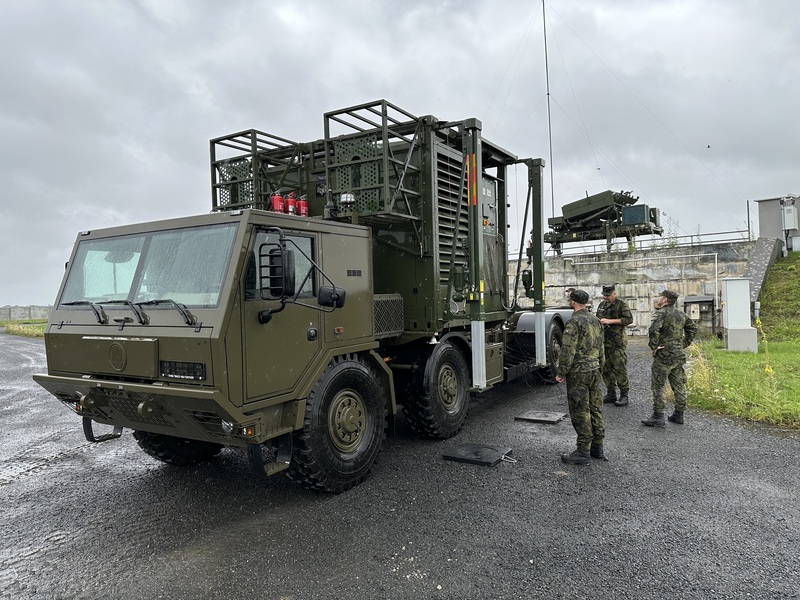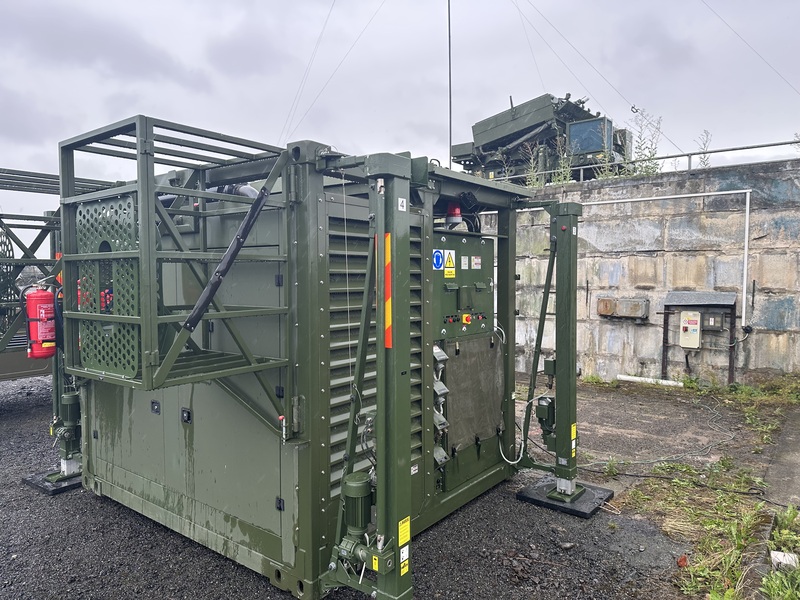Experiences of our soldiers with the MADR radar
Approximately one year ago we visited the 3rd Radio Engineering Company, 262nd Radio Engineering Battalion, 26th Command, Control and Reconnaissance Regiment in Stará Ves nad Ondřejnicí, where we had the opportunity to get acquainted with the new EL/M-2084 (MADR 3D) radar from Israeli supplier Israel Aerospace Industries (IAI). At that time, the military tests of this system had already been completed and the radar was newly introduced into the armament of the Czech Army. After more than a year since our last visit, we were interested to know how the Israeli system was perceived by the members of the 26th Command, Control and Reconnaissance Regiment (26th pVŘPz).

Eight pieces of 3D mobile radars MADR, which are part of the proven Israeli Iron Dome air defence system, were purchased on the basis of the Czech-Israeli contract on 5 December 2019. The first set arrived in the Czech Republic at the end of February 2022 and in December of the following year our army received the last - the eighth piece. The military trials of the MADR 3D radar had to be postponed due to securing all the necessary documents from the supplier, the high complexity of implementing the new system and the need to fully train the soldiers who will work with the Israeli system. The Army of the Czech Republic successfully completed the military trials in April 2023 and the Israeli radars began to be gradually integrated into the armament of the Army of the Czech Republic or the 262nd Radio Technical Battalion (262nd Rtpr).
The EL/M-2084 MMR 3D radars were primarily procured to replace obsolete Russian equipment that had exceeded its life cycle and was no longer suitable for contemporary and future operations. In addition to the replacement of the Russian equipment, the objective was also to acquire new capabilities such as mobility, detection of rocket, artillery and mortar munitions, CRAM, detection accuracy, detection probabilities. The EL/M-2084 MMR 3D radars were initially planned to be deployed in the Czech Air Defence System (NATINAMDS and NaPoSy) and also for strengthening NATO Capability Targets (strengthening of Air Surveillance Capability in NATO areas of interest). Within the framework of the activation of the National Reinforcement System (NaPoSy) of the Czech Republic, the EL/M-2084 MMR 3D radar is intended for the protection of objects of national defence importance (ODOS) or other strategic or tactical objects. To fulfil this task, EL/M-2084 MMR radars are allocated in cooperation with the assets of the 25th Anti-Aircraft Missile Regiment.

Due to the fact that the entire project was delayed by the contractor by several years and some of the kits have not been fully handed over to the 26th Command, Control and Reconnaissance Regiment, the comprehensive achievement of the 26th RCRF capabilities has also been delayed. For example, Full Operational Capability (FOC) as per Capability Targets was to be achieved by the end of 2025 after several years of preparation and training cycle. In order to eliminate the risk of the ACR not being able to meet its commitments, measures were taken to achieve at least initial operational capability according to the Capability Targets by the end of 2025. For the 26th Command, Control and Reconnaissance Regiment, this is a challenging task given that the training period was reduced to a minimum compared to the approved Operational Training Plan. In addition to the completion of the introduction of these radars and their deployment into the regiment's armament, training has already started and will continue intensively in 2025 in cooperation with other units of the Air Force.
For the 26th Command, Control and Reconnaissance Regiment, the year 2024 was a year of testing, validation and completion of full integration into many systems of the SAF and the Czech Armed Forces in many exercises, such as FECL (Federated Cloud, NaPoSy training, Clear Sky). During the National Reinforcement System exercise held in Bechyně, the ability to provide timely and accurate data to the 25th Anti-Aircraft Missile Regiment's fire assets was verified.

In 2025, the EL/M-2084 MMR 3D radar is expected to be deployed in live fire with the 25th Anti-Aircraft Missile Regiment as part of the BALT 2025 exercise. To achieve the aforementioned IOC, equipment has already been allocated and members of the 262nd Radio Engineering Battalion have been assigned to the task groups. The crew alignment phase is now underway.
In general, with the introduction of new equipment, there must be a change in attitude and mindset, which is the most complex challenge not only for the 26th Command, Control and Reconnaissance Regiment.
We asked the commander of the 26th pVŘPz, Colonel Zdeněk Pater, the following questions about the experience gained so far with the MADR radar.
How do the members of the 262nd Radiotechnical Battalion who work with the MADR assess the capabilities of this system in practice?
Since the entire project is not yet complete and is not expected to be completed until 2025, members of the 262nd Radio Engineering Battalion are involved in troubleshooting many of the technical issues and challenges associated with the introduction of military technology. On the one hand, this is lengthy and demanding, but on the other hand, it provides the technical and operational personnel of the 262nd Radio Engineering Battalion with valuable and otherwise unattainable knowledge and skills. I am in direct contact with these members and I dare say I know their feelings about such a lengthy process, which I have been part of since 2020. And despite some of the negative views, which are more to do with the 'birth pangs' of introducing military technology rather than the capabilities of the equipment, the positives prevail. There is still a long way to go to be completely satisfied, not only in terms of debugging some technical issues, but also because of the implementation of follow-on projects, such as the mobility augmentation vehicle.
How long did the training of the system operator take and were there any complications?
The training of instructors in the sense of "Train the Trains" was completed before the military exams and the subsequent training is conducted by the individual companies. Also, courses have been prepared under the auspices of the military academy in Vyškov, which each specialist must complete.
However, training is a continuous and never-ending process that will continue for years to come. The goal is for as many members of the 262nd Radio Technical Battalion to achieve Combat Ready qualification as quickly as possible.
I wouldn't say complications in training, but due to the complexity of this technology, a need was identified to focus training also on the details of setting up communications and information assets (switch, router, VzS transmission environment, airborne data network, etc.). This presents a number of challenges not only for the soldiers themselves, but also for the 262nd Radio Engineering Battalion, which is responsible for the training. This issue is being addressed in cooperation with the Communications and Information Systems Section of the MoD and I believe that a sufficient number of 262nd Rtpr personnel will be trained in the near future.

With what other systems (artillery, air force, etc.) does MADR within the Czech Armed Forces already share or should share information in the future?
The EL/M-2084 MMR's 3D radar sources both primary and secondary radar information, which is passed on to be further processed and fused with other sources of information to produce what is known as a Recognized Air Picture (RAP). For this purpose, the data is integrated into the Sector VS system. Due to the contemporary operational environment and the requirements for direct integration into different firing systems, cooperation with the 25th Anti-Aircraft Missile Regiment is ongoing. Primary and secondary radar information from the EL/M-2084 MMR radars is provided not only to the firing assets but also to the fire control systems. This information is also shared with foreign partners within NATINAMDS and is expected to be shared via the tactical datalink (JREAP-C) in the future.
How long have our MADR radars been in live operation as part of NATO's Integrated Air and Missile Defence System and how does the Alliance assess our involvement?
I think it is premature to ask for a comprehensive assessment by NATO, given, as I said, that not everything is yet complete. However, I can say that in October 2024, there was a SACEUR-grade NATINAMDS cash system checkout, which also involved EL/M-2084 MMR radars for RAP generation, and everything went very well. In particular, the approach of the Czech Armed Forces to joint defence and capability building, to which the Czech Republic has committed itself with regard to Air Surveillance Capability - strengthening the capability of airspace reconnaissance in NATO areas of interest - is positively assessed.
What inspirations or suggestions regarding the use of MADR radars in the Czech Armed Forces or in the Alliance (within the NATO Integrated Air and Missile Defence System) have the experience from the Ukrainian battlefield brought so far?
It clearly shows that active detection means, which include EL/M-2084 MMR radars, need to be combined with passive surveillance means, which remain "invisible" and thus less vulnerable during their operation. Use active means for the shortest possible time when active destruction by fire is required. This also implies the need to increase the mobility of all assets on the battlefield, not excluding radar equipment.
Do you think that the current eight MADR radars provide sufficient protection for the Czech Republic? Do you plan to expand the current number of these radars in the future, for example on the basis of the deteriorating security situation in Europe?
The current number of radars acquired was primarily based on the replacement of Russian equipment. However, it is not always the number that is important, but the capabilities that the Czech Armed Forces have acquired, or want to acquire, and from this point of view it is necessary to acquire additional radar equipment. This is in order to acquire, for example, the ability to detect ballistic missiles, which is also a key capability and experience from the Ukrainian battlefield. Among others, the Czech Army has defined this need in the Czech Armed Forces Development Concept 2035.
The future delivery of the Israeli SPYDER missile system to the 25th Anti-Aircraft Missile Regiment will also include MADR radars. Will your 262nd Radio Engineering Battalion then cooperate in any way with the 25th Anti-Aircraft Missile Regiment with regard to these radars?
Cooperation with the 25th Anti-Aircraft Missile Regiment has been going on for a long time because of joint tasks within the NaPoSy of the Czech Air Defence Forces. However, it is true that in terms of the acquisition of similar equipment (EL/M-2084 MMR radar, but in the two-vehicle version, as you have already written), the cooperation has intensified in the field of training, its setup, sharing of experience, and especially the aforementioned integration into the firing means.
Similar radars are being purchased by Slovakia and Hungary, is there any cooperation with these partners?
At the moment, both countries are in the process of introducing this technology into their Armed Forces, and therefore the cooperation is limited to sharing experiences in deployment, integration into command and control systems or firing assets. Joint procurement of spare parts or servicing is also a much discussed topic. This initiative is already being discussed within NATO, specifically by the NSPA, which has approached individual countries to see if they would be interested. Further discussions on this issue are now underway and will continue.





















